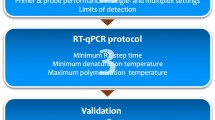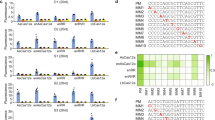Abstract
Following adeno-associated virus (AAV)-mediated transduction, cellular RNA preparations can be contaminated with AAV single-stranded DNA. The single-stranded DNA genome of recombinant AAV vectors can serve as an efficient, but undesirable, template for traditional reverse transcriptase-polymerase chain reaction (RT-PCR) methods. Consequently, recombinant AAV gene therapy presents a unique challenge to the design of sensitive and reliable methods to detect vector-derived mRNA. Several methods have been proposed to reduce the presence of single- and double-stranded vector DNA without compromising RNA specificity. For example, DNase I, although widely used, can be ineffective at completely removing the AAV single-stranded DNA genome. We have developed a sensitive real-time RNA-Specific reverse transcriptase PCR (RS-PCR) method that is independent of DNase I treatment. The RS-PCR method relies on the generation of a first-strand cDNA template using a primer with a linker sequence, X, at the 5′- end such that synthesis of second-strand cDNA incorporates the X-linker sequence into the cDNA template. The RS-PCR then utilizes forward and reverse primers targeting AAV vector sequence and the X-primer site, respectively, while a vector-specific Taqman probe makes sensitive real-time detection possible. We present data to validate the sensitivity and RNA specificity of the RS-PCR method and propose two unique endogenous control strategies by monitoring expression of both β-glucuronidase and endogenous cystic fibrosis transmembrane conductance regulator (CFTR). Finally, we demonstrate the utility of this new RS-PCR method in detecting recombinant AAV-CFTR expression, including, an in vitro transduction assay and methods to support both preclinical and clinical trials.
This is a preview of subscription content, access via your institution
Access options
Subscribe to this journal
Receive 12 print issues and online access
$259.00 per year
only $21.58 per issue
Buy this article
- Purchase on Springer Link
- Instant access to full article PDF
Prices may be subject to local taxes which are calculated during checkout









Similar content being viewed by others
References
Ferre F . Gene Quantification. Birkhauser: Boston, MA, 1998.
Freeman WM, Walker SJ, Vrana KE . Quantitative RT-PCR: pitfalls and potential. Biotechniques 1999; 26: 112–125.
Halford WP . The essential prerequisites for quantitative RT-PCR. Nat Biotechnol 1999; 17: 835.
Bustin SA . Absolute quantification of mRNA using real-time reverse transcription polymerase chain reaction assays. J Mol Endocrinol 2000; 25: 169–193.
Bartlett JS, Wilcher R, Samulski JR . Infectious entry pathway of adeno-associated virus and adeno-associated virus vectors. J Viol 2000; 74: 2777–2785.
Snyder RO . AAV and RT-PCR: true or false? Mol Ther 2000; 1: 389–390.
Rose AC et al. Optimization of real-time quantitative RT-PCR for the evaluation of non-viral mediated gene transfer to the airways. Gene Therapy 2002; 9: 1312–1320.
Grillo M, Margolis FL . Use of a reverse transcriptase polymerase chain reaction to monitor expression of intronless genes. Biotechniques 1990; 9: 262–268.
Roche Molecular Biochemicals. Roche Biochemicals Catalog, 2001.
Mutimer H, Deacon N, Crowe S, Sonza S . Pitfalls of processed pseudogenes in RT-PCR. Biotechniques 1998; 24: 585–588.
Mayall ES, Coutelle C . RT-PCR method specific for the detection of transgenic CFTR mRNA in the presence of transgene plasmid DNA and endogenous CFTR mRNA. Gene Therapy 1997; 4: 875–878.
Garbay B, Boue-Grabot E, Garret M . Processed pseudogenes interfere with reverse transcriptase-polymerase chain reaction controls. Anal Biochem 1996; 237: 157–159.
Moore RE, Shepherd JW, Hoskins J . Design of PCR primers that detect only mRNA in the presence of DNA. Nucleic Acids Res 1991; 18: 1921.
Shuldiner AR, Nirula A, Roth J . RNA template-specific polymerase chain reaction (RS-PCR): a novel strategy to reduce dramatically false positives. Gene 1990; 91: 139–142.
Shuldiner AR, Tanner K, Moore CA, Roth J . RNA template-specific PCR: an improved method that dramatically reduces false positives in RT-PCR. Biotechniques 1991; 11: 760–763.
Buchman GW, Schuster DM, Rashtchian A . Selective RNA amplification: a novel method using dUMP-containing primers and uracil DNA glycosylase. PCR Methods Appl 1993; 3: 28–31.
Heid CA, Stevens J, Livak KJ, Williams PM . Real time quantitative PCR. Genome Res 1996; 6: 986–994.
Gerard CJ et al. Improved quantitation of minimal residual disease in multiple myeloma using real-time polymerase chain reaction and plasmid-DNA complementarity determining region III standards. Cancer Res 1998; 58: 3957–3964.
Berns KI, Giraud C . Biology of adeno-associated virus. In: Berns KI, Giraud C (eds). Adeno-associate Virus (AAV) Vectors in Gene Therapy. Springer: New York, 1996, pp 1–18.
Sambrook J, Russel DW . Molecular Cloning: A Laboratory Manual. Cold Spring Harbor Laboratory Press: Cold Spring Harbor, NY, 2001.
Gerard CJ, Andrejka LM, Macina RA . Mitochondrial ATP synthase 6 as an endogenous control in the quantitative RT-PCR analysis of clinical cancer samples. Mol Diagn 2000; 5: 39–46.
Hamosh A et al. Severe deficiency of cystic fibrosis transmembrane conductance regulator messenger RNA carrying nonsense mutations R553X and W1316X in respiratory epithelial cells of patients with cystic fibrosis. J Clin Invest 1991; 88: 1880–1885.
Aitken ML et al. A phase I study of aerosolized administration of tgAAVCF to cystic fibrosis subjects with mild lung disease. Hum Gene Ther 2001; 12: 1907–1916.
Dell'Aringa J, Allen TL, Klump WM, Gerard CJ . Development of a sensitive quantitative real-time RNA specific PCR (RS-PCR) for the detection of AAV-derived TNFR:Fc mRNA in rat joints. Mol Ther 2002; 5: s280.
Acknowledgements
We would like to thank Barbara Thorne and Jim Richardson at Targeted Genetics Corporation for critical review of the manuscript and Thomas C Reynolds for helpful discussions and guidance.
Author information
Authors and Affiliations
Rights and permissions
About this article
Cite this article
Gerard, C., Dell'Aringa, J., Hale, K. et al. A sensitive, real-time, RNA-specific PCR method for the detection of recombinant AAV-CFTR vector expression. Gene Ther 10, 1744–1753 (2003). https://doi.org/10.1038/sj.gt.3302062
Received:
Accepted:
Published:
Issue Date:
DOI: https://doi.org/10.1038/sj.gt.3302062



